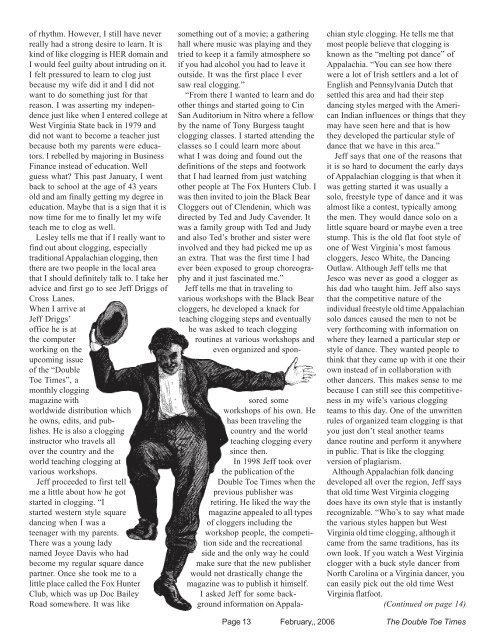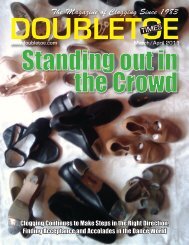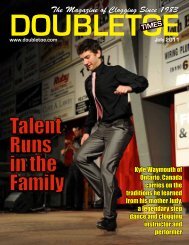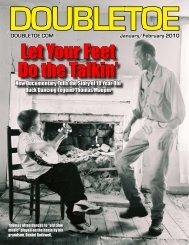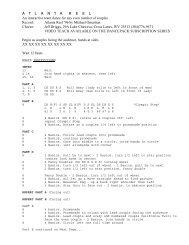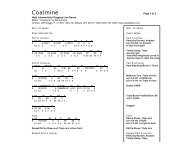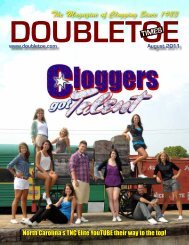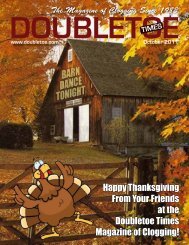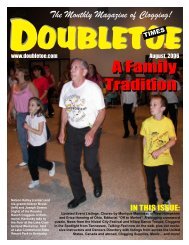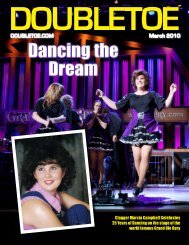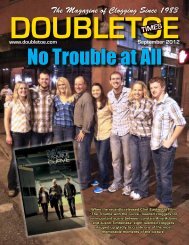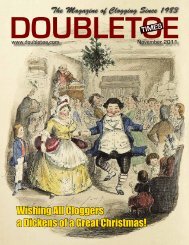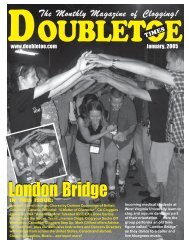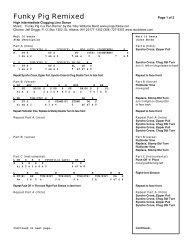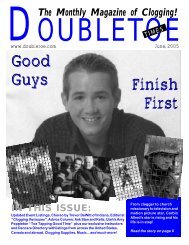Feb 2006 - Double Toe Times
Feb 2006 - Double Toe Times
Feb 2006 - Double Toe Times
You also want an ePaper? Increase the reach of your titles
YUMPU automatically turns print PDFs into web optimized ePapers that Google loves.
of rhythm. However, I still have never<br />
really had a strong desire to learn. It is<br />
kind of like clogging is HER domain and<br />
I would feel guilty about intruding on it.<br />
I felt pressured to learn to clog just<br />
because my wife did it and I did not<br />
want to do something just for that<br />
reason. I was asserting my independence<br />
just like when I entered college at<br />
West Virginia State back in 1979 and<br />
did not want to become a teacher just<br />
because both my parents were educators.<br />
I rebelled by majoring in Business<br />
Finance instead of education. Well<br />
guess what? This past January, I went<br />
back to school at the age of 43 years<br />
old and am finally getting my degree in<br />
education. Maybe that is a sign that it is<br />
now time for me to finally let my wife<br />
teach me to clog as well.<br />
Lesley tells me that if I really want to<br />
find out about clogging, especially<br />
traditional Appalachian clogging, then<br />
there are two people in the local area<br />
that I should definitely talk to. I take her<br />
advice and first go to see Jeff Driggs of<br />
Cross Lanes.<br />
When I arrive at<br />
Jeff Driggs’<br />
office he is at<br />
the computer<br />
working on the<br />
upcoming issue<br />
of the “<strong>Double</strong><br />
<strong>Toe</strong> <strong>Times</strong>”, a<br />
monthly clogging<br />
magazine with<br />
worldwide distribution which<br />
he owns, edits, and publishes.<br />
He is also a clogging<br />
instructor who travels all<br />
over the country and the<br />
world teaching clogging at<br />
various workshops.<br />
Jeff proceeded to first tell<br />
me a little about how he got<br />
started in clogging. “I<br />
started western style square<br />
dancing when I was a<br />
teenager with my parents.<br />
There was a young lady<br />
named Joyce Davis who had<br />
become my regular square dance<br />
partner. Once she took me to a<br />
little place called the Fox Hunter<br />
Club, which was up Doc Bailey<br />
Road somewhere. It was like<br />
something out of a movie; a gathering<br />
hall where music was playing and they<br />
tried to keep it a family atmosphere so<br />
if you had alcohol you had to leave it<br />
outside. It was the first place I ever<br />
saw real clogging.”<br />
“From there I wanted to learn and do<br />
other things and started going to Cin<br />
San Auditorium in Nitro where a fellow<br />
by the name of Tony Burgess taught<br />
clogging classes. I started attending the<br />
classes so I could learn more about<br />
what I was doing and found out the<br />
definitions of the steps and footwork<br />
that I had learned from just watching<br />
other people at The Fox Hunters Club. I<br />
was then invited to join the Black Bear<br />
Cloggers out of Clendenin, which was<br />
directed by Ted and Judy Cavender. It<br />
was a family group with Ted and Judy<br />
and also Ted’s brother and sister were<br />
involved and they had picked me up as<br />
an extra. That was the first time I had<br />
ever been exposed to group choreography<br />
and it just fascinated me.”<br />
Jeff tells me that in traveling to<br />
various workshops with the Black Bear<br />
cloggers, he developed a knack for<br />
teaching clogging steps and eventually<br />
he was asked to teach clogging<br />
routines at various workshops and<br />
even organized and sponsored<br />
some<br />
workshops of his own. He<br />
has been traveling the<br />
country and the world<br />
teaching clogging every<br />
since then.<br />
In 1998 Jeff took over<br />
the publication of the<br />
<strong>Double</strong> <strong>Toe</strong> <strong>Times</strong> when the<br />
previous publisher was<br />
retiring. He liked the way the<br />
magazine appealed to all types<br />
of cloggers including the<br />
workshop people, the competition<br />
side and the recreational<br />
side and the only way he could<br />
make sure that the new publisher<br />
would not drastically change the<br />
magazine was to publish it himself.<br />
I asked Jeff for some background<br />
information on Appalachian<br />
style clogging. He tells me that<br />
most people believe that clogging is<br />
known as the “melting pot dance” of<br />
Appalachia. “You can see how there<br />
were a lot of Irish settlers and a lot of<br />
English and Pennsylvania Dutch that<br />
settled this area and had their step<br />
dancing styles merged with the American<br />
Indian influences or things that they<br />
may have seen here and that is how<br />
they developed the particular style of<br />
dance that we have in this area.”<br />
Jeff says that one of the reasons that<br />
it is so hard to document the early days<br />
of Appalachian clogging is that when it<br />
was getting started it was usually a<br />
solo, freestyle type of dance and it was<br />
almost like a contest, typically among<br />
the men. They would dance solo on a<br />
little square board or maybe even a tree<br />
stump. This is the old flat foot style of<br />
one of West Virginia’s most famous<br />
cloggers, Jesco White, the Dancing<br />
Outlaw. Although Jeff tells me that<br />
Jesco was never as good a clogger as<br />
his dad who taught him. Jeff also says<br />
that the competitive nature of the<br />
individual freestyle old time Appalachian<br />
solo dances caused the men to not be<br />
very forthcoming with information on<br />
where they learned a particular step or<br />
style of dance. They wanted people to<br />
think that they came up with it one their<br />
own instead of in collaboration with<br />
other dancers. This makes sense to me<br />
because I can still see this competitiveness<br />
in my wife’s various clogging<br />
teams to this day. One of the unwritten<br />
rules of organized team clogging is that<br />
you just don’t steal another teams<br />
dance routine and perform it anywhere<br />
in public. That is like the clogging<br />
version of plagiarism.<br />
Although Appalachian folk dancing<br />
developed all over the region, Jeff says<br />
that old time West Virginia clogging<br />
does have its own style that is instantly<br />
recognizable. “Who’s to say what made<br />
the various styles happen but West<br />
Virginia old time clogging, although it<br />
came from the same traditions, has its<br />
own look. If you watch a West Virginia<br />
clogger with a buck style dancer from<br />
North Carolina or a Virginia dancer, you<br />
can easily pick out the old time West<br />
Virginia flatfoot.<br />
(Continued on page 14)<br />
Page 13 <strong>Feb</strong>ruary,, <strong>2006</strong> The <strong>Double</strong> <strong>Toe</strong> <strong>Times</strong>


